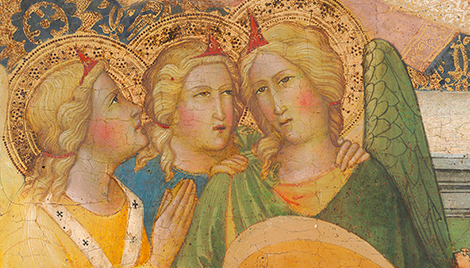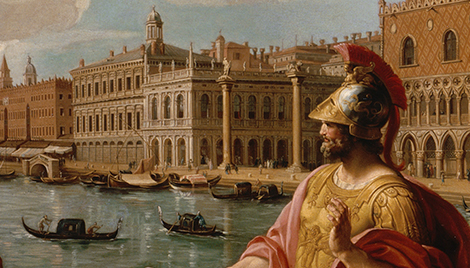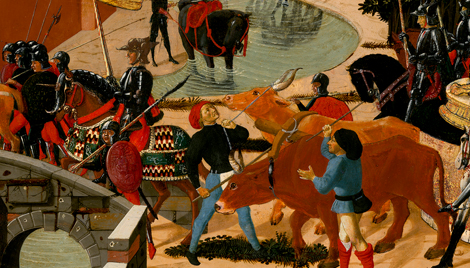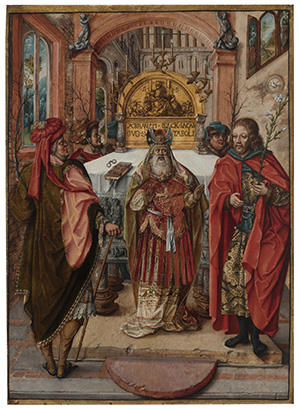Suitors of Mary
Suitors of Mary
- Artist
- Anton Woensam
- Artist Dates
- active c. 1500-1541
- Artist Nationality
- German
- Title
- Suitors of Mary
- Date
- c. 1520
- Medium
- oil on panel
- Dimensions
- 66 x 47.3 cm (26 x 18-5/8 in)
- K Number
- K2128
- Repository
- Allentown Art Museum
- Accession Number
- 1961.056.000
- Notes
Provenance
Sir Charles Douglas, 1882; Lady Margaret Douglas. Lady Hilda Seely [d. 1939], King's Manor, Yarmouth Isle of Wight. [1] (Mortimer Brandt Gallery, New York), by 1941. [2] (Norton Galleries, New York); sold to Samuel H. Kress [1863-1955] on 2 November 1955; gift to the Allentown Art Museum in 1961, no. 1961.56. [1] Some of Lady Seely's collection was sold at two sales at Christies, London, in 1940 but this painting was not included. [2] Brandt was probably the lender to From Van Cleve to Tiepolo, David Koetser Gallery, New York, 1941, no. 21.
Catalogue Entry
Anton Woensam
Suitors of Mary
K2128
Allentown, Pennsylvania, Allentown Art Museum, since 1960. Oil on oak. 26 X 18 5/8 in. (66.0 x 47.3 cm.). Inscribed on the lower section of the tabernacle: ABRAHAM ISACK IACAB(1) DVO SV [NT] TABOLI ('There are two tablets'.)(2) The reference to the tablets as well as the letters M and S on either side of the central image of Moses refer to him. The artist's initials T W (Thonis Woensam) appear to the left and right of the head of Moses, and again on a flagstone at the lower left. His name is also painted on the priest's prayer shawl: TVONNI[S] WONS[AM]. Restored by Modestini in 1960. Well preserved. Allentown, 1960, p. 104. According to the Apocrypha an angel appeared to the High Priest (when Mary, aged twelve, was in the temple) instructing him to distribute rods to all the widowers in Judea. Whichever man received a sign from the Lord was to be the Virgin's bridegroom. Joseph, the last to be given a rod, had a dove appear upon it. The bird then settled on Joseph's head whereupon the priest selected him.(3) Other legends have the dry rod flowering as shown in K2128 where the branch has turned into a lily (symbol of virginity). The figures of combatants at the upper left and right probably symbolize Discord before the time of Christ, based on Netherlandish prototypes such as the Petrus Christus Nativity (Washington, D.C., National Gallery of Art). The Italianate, sarcophagus-like altar, together with the Romanesque architectural setting, symbolize the Old Dispensation, as do Moses' tablets.(4) The triptych hanging on the temple wall at the upper right has prophets in its wings; Moses before the Burning Bush is the central subject, all prophesying the Incarnation, which is further indicated by the Holy Ghost and Joseph's branch of lilies immediately below. Shapley (Allentown, loc. cit.) found reminders of Danubian painting and North Italian decorative motifs in K2128. According to Schrader, the panel is an early work by Woensam close in style but painted prior to the St. Gereon Altar (Munich, Pinakothek) of 1520, also noting the influence of Netherlandish mannerist painters of the period, such as Jacob Cornelisz. van Amsterdam.(5) K2128 was probably part of a series of scenes relating to the Life of the Virgin and could have been placed next to a depiction of the Betrothal. The subject usually occupies a subsidiary role, relegated to the background of the Marriage of the Virgin – as shown in van Meckenem's engraving of the latter. In the print (B.33) the suitors march around the altar holding their branches; only Joseph's, as in K2128, has come to life, all the others remaining bare. Both print and painting show Joseph at the right; both have the artist's name inscribed upon the altar, which features the tablets of the Law.(6) Many of the emblematic components of The Miracle of the Rod are found similarly disposed in the works of Joos van Cleve who was active in Cologne in 1515 and may have provided the prototype for K2128. Provenance: Sir Charles Douglas, 1882. Lady Margaret Douglas. Lady Seely, Kings Manor, Yarmouth (Isle of Wight).(7) New York, Mortimer Brandt Gallery, exhibited –New York, Koetser Gallery, From Van Cleve to Tiepolo, 1941, Cat. No. 21, where it is noted that K2128 was recognized as a Woensam by Ernst Buchner. New York, Norton Galleries. Kress acquisition 1955.
References
(1) The association of Abraham, Isaac, and Jacob may refer to the Tree of Jesse – the lineage of Christ – as given in Matthew 1:2, beginning 'Abraham was the father of Isaac and Isaac the father of Jacob ...'. The letters surrounding Moses may possibly be an abbreviation for Matthew, as it is his gospel which begins with the ancestry of Christ. See also Matthew 22:32. (2) Dr. Hugo Buchthal has assisted in interpreting the inscription. (3) For accounts of the 'Suitors of Mary', see The Apocryphal New Testament, transl. by M. R. James, Oxford, 1924, 'The Gospel of Pseudo-Matthew', p. 73; Jacques de Voragine, La Legende Dorée (transl. by Teodor de Wyzewa, Paris, 1925, pp. 496-7, text 4, 'The Birth of the Blessed Virgin', CXXIX). (4) Panofsky, I, pp. 136-7. Similar symbolism is found in a depiction of the same subject by Robert Campin (Madrid, Prado). (5) John L. Schrader, 'The Agony in the Garden by Anton Woensam', The Register of the Museum of Art, The University of Kansas, II, 1963, pp. 8-16. (6) Max Lehrs, Geschichte und Kritischer Katalog, IX, Israhel van Meckenem, Cat. No. 53, pl. 267, fig. 644. (7) The Douglas and Seely ex colls. are according to the Norton Galleries.






